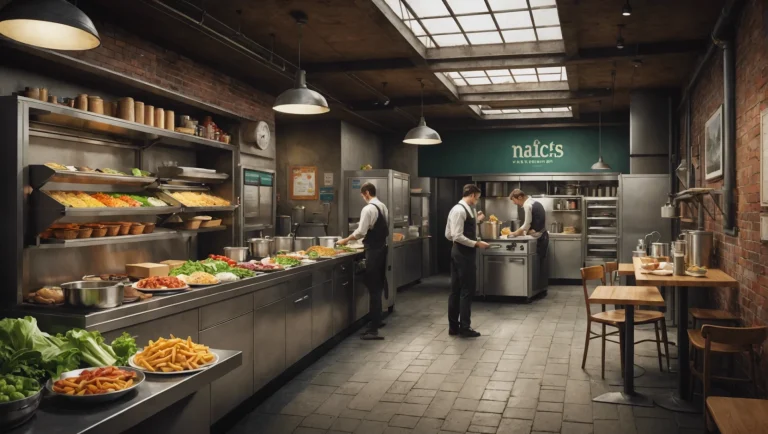Restaurants throw away 33 billion pounds of food every year in the US alone. That’s enough to feed hungry people to fill the Empire State Building 32 times. Discover how the front of house operations in restaurants can significantly impact waste reduction, contributing to a more sustainable and responsible food service industry.
Food waste isn’t just bad for the planet. It’s also bad for business, wasting food and eating up 2-6% of restaurant profits.
Food Waste In Food Service
Businesses lose $2.6 trillion each year to food waste
Metrobi drivers are rated 4.97/5
Trusted by local businesses for:
- Background-checked professionals
- Specialized in business deliveries
- Same drivers for consistency
- 4.97/5 average delivery rating
Implement Food Waste Reduction Strategies to Cut Costs and Improve Sustainability
Reducing food waste is a critical step for restaurants looking to improve their bottom line and minimize their environmental impact. By implementing targeted strategies, restaurants can cut costs associated with purchasing, preparing, and disposing of wasted food, while also contributing to a more sustainable future. Discover how a printer for the kitchen can be integral in reducing food waste by improving order accuracy and streamlining the preparation process.
Conduct a Food Waste Audit to Identify Areas for Improvement
The first step in reducing food waste is to understand where discarded food ends up and how much food occurs in your restaurant. Conducting a thorough food waste audit involves:
Tracking and measuring food waste for a designated period, usually a week or more
Analyzing the data to pinpoint the main sources of waste, such as specific dishes, ingredients, or processes
Setting specific, measurable goals for reducing waste based on the audit findings
Implement A Waste-Tracking System
To effectively track and prevent food waste, assign a team member to monitor and record the food waste statistics at key points in the food preparation and service process. This may include:
Weighing or counting wasted ingredients during prep
Noting the number of uneaten meals returned to the kitchen
Tracking the amount of food discarded at the end of each shift
Consistently recording this data will provide valuable insights into your restaurant’s waste patterns.
Analyze The Data and Identify Waste Hotspots
Once you have collected waste data, analyze it to identify the main contributors to food waste in your restaurant. Look for:
Dishes that consistently generate the most plate waste
Ingredients that are frequently over-prepped or spoiled before use
Processes or policies that lead to unnecessary waste, such as inflexible portion sizes or improper storage techniques
You can use this information to prioritize areas for improvement and set specific household waste reduction goals.
Optimize Portion Sizes to Reduce Plate Waste
One of the most effective ways to reduce food waste in restaurants is to optimize portion sizes. When customers are made too much food or served portions that are too large, they are more likely to leave uneaten food on their plates, contributing to waste. Discover how selecting the appropriate software for managing restaurant operations can help you precisely adjust portion sizes, cut down on food waste, and enhance your establishment’s sustainability.
To minimize plate waste:
Review and adjust portion sizes based on customer feedback and plate waste data
Offer half-portions or smaller sizes for lighter appetites or smaller groups
Train staff to be mindful of portion control when plating dishes, and to ask customers if they want certain sides or garnishes before serving
Conduct Plate Waste Studies
To determine the optimal portion sizes for your menu items, conduct plate waste studies. This involves:
Measuring the amount of uneaten food returned to the kitchen for each dish
Analyzing the data to identify which dishes consistently have the most waste
Adjusting portion sizes accordingly and re-evaluating plate waste to ensure the changes are effective
By serving portions of nutritious food that are satisfying but not excessive, you can reduce plate waste and save on food costs.
Revamp Your Menu to Prioritize Wasted Food Reduction
Another key strategy for reducing food waste is to design your menu with waste reduction in mind. This may involve:
Featuring dishes that use commonly wasted ingredients in creative ways
Offering flexible menu options, such as build-your-own dishes or customizable sides
Highlighting smaller portion sizes or half-orders as an attractive option for guests
Cross-Utilize Ingredients
Look for opportunities to use ingredients across multiple dishes to minimize waste. For example:
If you have leftover roasted vegetables from a dinner special, use them in a breakfast hash or lunchtime wrap
Repurpose stale bread into croutons, breadcrumbs, or a Panzanella salad
Use meat or vegetable trimmings to make stocks, soups, or sauces
By finding creative ways to cross-utilize ingredients, you can reduce waste while also adding variety and interest to your menu.
Train and Engage Staff In Waste Reduction Efforts
Successfully reducing food waste in the food production chain in your restaurant requires the active participation and support of your entire staff. To engage your team:
Provide training on proper food handling, storage, and portion control techniques
Encourage kitchen staff to find creative ways to repurpose excess ingredients
Incentivize waste reduction efforts through recognition programs or friendly competitions
Regularly communicate progress towards waste reduction goals and celebrate successes
Foster A Culture of Sustainability
Make waste reduction a core part of your restaurant’s culture by:
Communicating the environmental and financial benefits of reducing waste to your staff
Leading by example and demonstrating a commitment to sustainability in your actions
Providing ongoing education and resources to help staff identify and implement waste reduction opportunities
Recognizing and rewarding staff members who go above and beyond in their waste reduction efforts
By engaging your staff and making waste reduction a team effort, you can create a culture of sustainability that permeates every aspect of your restaurant’s operations. Explore the depths of managing a dining establishment, from engaging your staff to optimizing waste reduction, and uncover the intricacies involved in the operations of a restaurant.
Implementing these food waste reduction strategies – from conducting more food waste audits to optimizing portion sizes and engaging staff – can help restaurants significantly cut costs, improve their environmental impact, and contribute to the global effort to combat food waste. By taking a proactive and data-driven approach to food waste prevention and reduction, restaurants can boost their bottom line while also making a positive impact on the planet. To further enhance profitability, restaurants should also focus on increasing their table turnover rate. By optimizing seating arrangements and streamlining service during peak hours, eateries can improve operational efficiency and boost overall revenue. Learn more about effective strategies to enhance your table turnover rate in our comprehensive guide for 2025.
Food Waste In the United States
Restaurants in the United States generate approximately 22 to 33 billion pounds of food waste each year
Metrobi is transforming catering deliveries
Specialized solutions for catering businesses:
- Catering-trained drivers
- Proper handling equipment
- Peak day delivery support
- 23% average cost reduction
Adopt Sustainable Restaurant Practices to Minimize Waste and Boost Efficiency
Reducing food waste is a critical concern for restaurants looking to improve their bottom line and minimize their environmental impact. By preventing food waste and adopting sustainable practices, restaurants can significantly decrease the amount of food that ends up in the trash, saving money and natural resources in the process. Explore the essential facets of managing restaurant functions, from cutting down food waste to sustainable innovations, and uncover the operational intricacies that make a restaurant successful.
Implement A Food Inventory Management System
One of the most effective ways to reduce food wastage is by implementing a robust food inventory management system. This system should include the use of software to track inventory levels and expiration dates, ensuring that ingredients are used before they spoil. By accurately forecasting demand and ordering ingredients based on these projections, restaurants can avoid overordering and minimize the risk of waste. Considering strategies to enhance your food inventory management in the restaurant industry? Adopt these expert suggestions to diminish wastage and boost your bottom line.
Use Software To Track Inventory Levels and Expiration Dates
Investing in inventory management software can help streamline the process of tracking stock levels and expiration dates. These programs can generate alerts when ingredients are nearing their expiration, allowing staff to prioritize their use and prevent spoilage. Some popular inventory management software options for restaurants include:
Toast Inventory Management
BevSpot
MarketMan
Upserve Inventory
Inventory Management Software
Nearly half (42%) of restaurants use inventory management software to reduce waste
Order Ingredients Based On Accurate Forecasting To Avoid Overordering
To minimize overordering, restaurants should analyze historical sales data and factor in seasonal fluctuations, special events, and menu changes when placing orders. By using data-driven insights to inform purchasing decisions, restaurants can ensure they have the right amount of ingredients on hand without risking excess waste.
Regularly Rotate Stock To Ensure Older Items Are Used First
Proper stock rotation is essential for reducing food waste. You should train staff to use the first-in, first-out (FIFO) method, which ensures that older ingredients are used before newer ones. This practice can be reinforced by clearly labeling ingredients with their arrival dates and organizing storage areas so that older items are easily accessible.
Repurpose Excess Ingredients and Trim Them Into New Dishes
Despite best efforts to minimize overordering, restaurants may still find themselves with excess ingredients or trim. Rather than discarding these items, creative chefs can repurpose them into new dishes, reducing waste and potentially boosting profits.
Create Daily Specials Featuring Excess Ingredients Or Trim
One way to use up excess ingredients is by featuring them in daily specials. For example, if a restaurant finds itself with an abundance of zucchini, the chef could create a special zucchini fritter appetizer or a zucchini noodle dish. By highlighting these specials on the menu or through server recommendations, restaurants can sell through excess ingredients while offering customers unique and enticing options.
Use Vegetable Scraps and Meat Bones to Make Stocks and Soups
Vegetable scraps and meat bones can be used to create flavorful stocks and soups, reducing waste and adding value to the menu. For example, carrot peels, onion skins, and celery leaves can be simmered with water and herbs to create a vegetable stock that can serve as the base for soups, sauces, and risotto. Similarly, meat bones can be roasted and then simmered with vegetables and aromatics to create rich and nutritious stocks for soups, stews, and braises.
Incorporate Leftover Bread Into Croutons, Breadcrumbs, or Bread Pudding
Leftover bread can be easily transformed into a variety of tasty and useful ingredients. Stale bread can be cut into cubes, tossed with olive oil and seasonings, and baked until crispy to make croutons for salads and soups. Bread can also be pulsed in a food processor to create breadcrumbs for coating meats, topping casseroles, or adding texture to meatballs. For a sweet treat, leftover bread can be cubed and combined with eggs, milk, sugar, and spices to create a comforting bread pudding dessert.
By implementing a food inventory management system and repurposing excess ingredients, restaurants can significantly reduce their food waste, lower costs, and improve their environmental sustainability. These practices not only benefit the bottom line but also demonstrate a commitment to responsible and ethical operations, which can help attract and retain environmentally conscious customers.
Profitability of Reducing Food Waste
Each $1 in saved food creates $14 in additional revenue

Discover Cost-Saving Tips for Restaurants to Boost Bottom Line
Partner With Local Farmers and Suppliers
Partnering with local farmers and suppliers is an effective way to reduce food waste and cut costs. By sourcing ingredients directly from local producers, restaurants can reduce transportation costs and minimize waste associated with long-distance shipping. This also ensures that the ingredients are fresher and of higher quality, which can lead to less food, better-tasting dishes, and increased customer satisfaction.
To make the most of local partnerships, restaurants should negotiate bulk purchasing agreements for frequently used items. This can help secure better prices and ensure a steady supply of essential ingredients. Additionally, working closely with suppliers to minimize packaging waste can further reduce costs and environmental impact.
Train Staff on Waste Reduction Best Practices
Engaging and educating staff is crucial to the success of any serious food waste challenge or reduction initiative. Restaurant managers should train employees on the importance of reducing food waste and provide them with the tools and knowledge to do so effectively. Effective training goes beyond teaching food handling techniques; it also encompasses enhancing the overall guest experience. Discover practical methods and tips for training your employees to elevate their skills in providing exceptional restaurant customer service, which complements your waste reduction efforts by fostering a positive environment and improving customer satisfaction.
Implementing a waste-tracking system is a key step in this process. By setting waste reduction targets for each shift and monitoring progress, restaurants can identify areas for improvement and hold staff accountable. This data can also be used to recognize and reward employees who excel at minimizing waste, creating a positive feedback loop that encourages continuous improvement.
Best Practices For Staff Training and Engagement
Conduct regular training sessions on waste reduction techniques, such as proper portion control and efficient food preparation
Create a team of “waste reduction champions” who can mentor other staff members and lead by example
Implement a suggestion box or feedback system to gather ideas from staff on how to further reduce waste
Celebrate successes and recognize top performers to keep staff motivated and engaged
By partnering with local suppliers and training staff on waste reduction best practices, restaurants can significantly reduce food waste and operating costs. These cost-saving measures not only boost profitability but also demonstrate a commitment to sustainability that can attract environmentally conscious customers.
Embrace Eco-Friendly Restaurant Management to Attract Environmentally Conscious Customers
In today’s world, more and more consumers are becoming environmentally conscious and seeking out businesses that align with their values. By embracing eco-friendly restaurant management practices, you can attract this growing segment of customers while also reducing your environmental impact and boosting your bottom line.
Implement A Composting Program
Composting is an effective way to divert food waste from landfills and reduce your restaurant’s environmental footprint. By partnering with a local composting facility, you can ensure that your food scraps are properly broken down and transformed into nutrient-rich soil.
Partner With A Local Composting Facility
It is better to research composting facilities in your area and choose one that aligns with your restaurant’s needs and values. You can establish a partnership and work with them to develop a customized composting plan for your restaurant. For example, Royal Waste Services offers comprehensive waste management solutions, including composting programs, to help restaurants minimize their environmental impact.
Train Staff on Proper Composting Procedures
Educate your staff on the importance of composting and provide them with clear guidelines on what can and cannot be composted. Designate specific bins for compostable materials and ensure that they are easily accessible to all staff members. This training is crucial to ensure that employees are equipped with the knowledge and skills to properly sort waste, recycle, and compost.
Communicate Your Composting Efforts To Customers
Let your customers know about your composting program by displaying signs or information on your menu, website, and social media channels. This will showcase your commitment to sustainability and attract environmentally conscious diners.
Reduce Single-Use Plastics And Disposables
Single-use plastics and disposables, such as straws, utensils, and takeout containers, contribute significantly to environmental waste. By reducing your reliance on these items, you can minimize your restaurant’s environmental impact and appeal to eco-conscious customers.
Switch To Reusable Or Biodegradable Serving Ware and Utensils
Invest in reusable serving ware and utensils, such as ceramic plates and metal cutlery, to reduce waste and enhance your customers’ dining experience. For takeout or delivery orders, opt for biodegradable or compostable alternatives to traditional plastic containers. This can include using eco-friendly cleaning products and sustainable equipment, which are essential for maintaining a sustainable restaurant.
Offer Straws Only Upon Request and Consider Eco-Friendly Alternatives For Food Loss and Waste
Instead of automatically providing plastic straws with every drink, offer them only when requested by customers. Consider switching to eco-friendly alternatives, such as paper or metal straws, to further reduce your environmental impact. This is especially important, as single-use plastics are a significant contributor to plastic pollution and harming ecosystems.
Encourage Customers To Bring Their Reusable Containers For Takeout or Leftovers
Incentivize customers to bring their reusable containers for takeout orders or leftovers by offering a small discount or loyalty points. This not only reduces waste but also fosters a sense of community and shared responsibility for the environment. Restaurants can also consider implementing recycling and composting programs to further reduce waste.
By implementing these eco-friendly restaurant management practices, you can attract environmentally conscious customers, enhance your restaurant’s reputation, and ultimately boost your profits. As more consumers prioritize sustainability, embracing these practices will help your restaurant stay ahead of the curve and remain competitive in the industry.
Understanding Food Waste in the Restaurant Industry
Definition of Food Waste
Food waste refers to any food that is discarded, unused, or uneaten. In restaurants, this can include ingredients that spoil before being used as perfectly good food, as well as prepared dishes that are not consumed by customers. Food waste can occur at any stage of the food supply chain, from the farm where ingredients are grown to the plate where meals are served. Gain insights into how the back of house in restaurants plays a crucial role in minimizing food waste and maintaining efficiency, from managing inventory to preparing dishes.
According to a report by the Food and Agriculture Organization of the United Nations, approximately one-third of all food produced for human consumption is lost or wasted globally. This amounts to about 1.3 billion tons of food waste per year. In the United States alone, the restaurant industry is responsible for an estimated 11.4 million tons of food waste annually.
Impact of Food Waste on the Environment and Economy
The environmental impact of food waste is significant. When food is discarded in landfills, it decomposes and releases methane, a potent greenhouse gas that contributes to climate change. If global food waste were a country, it would be the third-largest emitter of greenhouse gases, behind only China and the United States.
In addition to its environmental impact, food waste also has economic consequences for restaurants. Wasted or discarded food also represents lost revenue and resources, as restaurants must purchase ingredients that ultimately go unused. According to a study by the World Resources Institute, restaurants in the United States spend an estimated $162 billion annually on food that is never eaten.
The True Cost of Food Waste for Restaurants
The cost of food waste extends beyond the price of the food wasted and the ingredients themselves. Restaurants must also consider the labor costs associated with preparing and handling food that ultimately goes to waste. Additionally, there are costs associated with disposing of food waste, such as hauling fees and landfill tipping fees.
By reducing food waste, restaurants can significantly improve their bottom line. According to a study by the National Restaurant Association, restaurants that implement food waste reduction strategies can save an average of $7 for every $1 invested in those strategies. Discover how to enhance your restaurant’s efficiency and profitability by mastering the top techniques in restaurant management, ensuring a significant return on your investment in food waste reduction strategies.
Common Sources of Food Waste in Restaurants
To effectively reduce food waste, restaurants need to identify the most common sources of food waste hierarchy in their operations. Some of the most common sources of food waste in restaurants include:
Overproduction and Large Portion Sizes
One of the most significant sources of food waste in restaurants is overproduction. This occurs when restaurants prepare more food than is needed to meet customer demand. Overproduction can be the result of inaccurate forecasting, or it may be a deliberate strategy to ensure that the restaurant does not run out of popular menu items.
Large portion sizes can also contribute to food waste, as customers may not be able to finish their meals.
Improper Storage and Handling of Ingredients
Another common source of food waste in restaurants and grocery stores is improper storage and handling of ingredients. When ingredients are not stored at the proper temperature or are not used before their expiration date, they can spoil and become unusable.
Proper storage and handling practices are essential for reducing food waste in restaurants. This includes storing ingredients at the appropriate temperature, using the first-in, first-out (FIFO) method for inventory management, and storing food properly by regularly checking expiration dates.
Inefficient Inventory Management and Overordering of Supplies
Inefficient inventory management and overordering of supplies can also contribute to food waste in restaurants. When restaurants order more ingredients than they need, those ingredients may spoil before they can be used.
To reduce waste from overordering, restaurants can implement inventory management systems that track usage and predict future demand. This can help restaurants order the right amount of ingredients and supplies, reducing waste and saving money.
Benefits of Reducing Food Waste for Restaurants
Cost savings and Improved Profitability
Minimizing food waste can significantly impact a restaurant’s bottom line. By reducing the amount of food that goes unused, restaurants can lower their overall food costs, which directly translates to increased profit margins. According to ReFED, an annual investment of $18 billion can reduce food waste across the food system by more than 21 million tons each year and generate $78 billion in annual net financial benefit. Implementing strategies such as portion control, proper inventory management, and repurposing excess ingredients can help restaurants minimize waste and optimize their food costs.
In addition to the direct cost of wasted food production, restaurants also incur expenses related to waste disposal. By reducing the volume of food waste generated, restaurants can lower their waste disposal costs, further contributing to improved profitability.
Enhanced Sustainability and Environmental Responsibility
Reducing food waste not only benefits a restaurant’s financial health but also demonstrates a commitment to environmental sustainability. The food service industry is a significant contributor to global food waste, with an estimated 38% of all food going unsold or uneaten in the U.S., equivalent to 145 billion meals annually, valued at $473 billion. By decreasing food waste, restaurants can reduce their carbon footprint and minimize their environmental impact. This commitment to sustainability can attract eco-conscious customers who prioritize supporting businesses that align with their values.
Demonstrating environmental responsibility can also improve a restaurant’s brand reputation and differentiate them from competitors. Implementing sustainable practices, such as composting, recycling, and partnering with local farmers, can generate positive publicity and enhance customer loyalty.
Positive Impact On Local Communities and Food Insecurity
Restaurants can make a positive impact on food security in their local communities by donating excess food to food banks or shelters. In the United States, an estimated 38 million people, including 12 million children, face food insecurity, according to Feeding America. By partnering with food recovery or with organizations that redistribute surplus food, restaurants can help support those in need while reducing their food waste.
Donating excess food not only addresses food insecurity but also strengthens community ties and generates positive publicity for the restaurant. Many food donation programs, such as Food Donation Connection and Feeding America’s MealConnect, make it easy for restaurants to make food donations, connect with local food banks, and streamline the healthy food donation process.
Furthermore, some countries offer tax incentives for businesses and local governments that donate excess food to charitable organizations. For example, in the United States, the Bill Emerson Good Samaritan Food Donation Act provides liability protection for businesses that donate food in good faith, encouraging more restaurants to participate in food donation programs.
Consumer Consciousness
72% of consumers are more conscious about food waste, and 91% prefer to purchase from restaurants that reduce food waste
Improved Inventory Management and Kitchen Efficiency
Implementing strategies to reduce food waste often leads to improved inventory management and increased kitchen efficiency. By closely monitoring inventory levels and using data-driven approaches to forecasting demand, restaurants can minimize overordering and ensure that ingredients are used before they spoil.
Proper inventory management tools, such as FIFO (First In, First Out) systems and digital inventory tracking software, can help restaurants streamline their processes and reduce the risk of waste due to oversights or human error. These tools can also provide valuable insights into ingredient usage patterns, enabling restaurants to make more informed purchasing decisions.
In addition to inventory management, reducing food waste can also encourage kitchen staff to be more creative and efficient in their use of ingredients. By finding ways to repurpose excess ingredients or trim, such as using vegetable scraps to make stocks or sauces, restaurants can minimize waste while also creating unique and flavorful dishes.
Boosted Employee Morale and Engagement
Engaging employees in food waste reduction efforts can boost morale and foster a sense of purpose within the restaurant team. When staff members feel that their actions contribute to a greater good, such as reducing environmental impact or supporting the local community, they are more likely to be engaged and motivated in their work.
Restaurants can involve employees in food waste reduction initiatives by providing training on proper food handling, storage, and repurposing techniques. Encouraging staff to share their ideas for reducing food waste globally and implementing the most promising suggestions can create a sense of ownership and pride in the restaurant’s sustainability efforts.
Moreover, recognizing and rewarding employees who demonstrate a commitment to reducing food waste can further reinforce the importance of these efforts and encourage ongoing participation. This recognition can take the form of bonuses, promotions, or even simple acknowledgments during team meetings.
By fostering a culture of sustainability and waste reduction, restaurants can not only improve their bottom line but also attract and retain talented staff who value working for environmentally responsible businesses.
Food Waste In America
Americans throw away more than $160 billion in food annually
Embracing Sustainable Practices for a Thriving Restaurant
Reducing food waste is not only good for the environment but also great for your restaurant’s bottom line. By implementing simple strategies like conducting waste audits, optimizing portion sizes, and repurposing excess ingredients, you can significantly cut costs and improve efficiency.
Partnering with local suppliers, training your staff, and embracing eco-friendly practices will further enhance your sustainability efforts while attracting environmentally conscious customers.
So, what’s the first step you’ll take to reduce food waste in your restaurant? Whether it’s conducting a waste audit or implementing a composting program, every small action counts. By making sustainable practices a priority, you’ll be well on your way to running a more profitable and environmentally responsible restaurant.
Remember, reducing food waste is an ongoing process that requires commitment and collaboration from your entire team. But the benefits – cost savings, improved sustainability, and a positive impact on your community – are well worth the effort.














